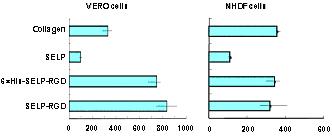J. Yao1, and T. Asakura2
1 The Key Laboratory of Advanced Textile Materials and Manufacturing Technology of Ministry of Education, Collage of Materials and Textile, Zhejiang University of Sciences, Hangzhou 310018, China
2 Department of Biotechnology, Tokyo University of Agriculture and Technology, Koganei, Tokyo 184-8588, Japan.
Introduction: Silks have many inherent superior properties as biomaterials in the viewpoints of mechanical properties, environmental stability and biocompatibility. In this research, silk-like materials were designed and produced with genetically engineering synthesis method, which were generally combined with the structural units selected from Bombyx mori silk fibroin and animal elastin, and the functional units, e.g., RGD sequence, derived from fibronectin in order to improve the cell adhesion property.
Materials and Methods: Bacterial growth in rich medium, DNA manipulations, and transformation conditions were performed as described previously.1,2 Batch cultures were performed on MDL-6C Fermentor (B. E. Marubishi Co.), with 1.2 L working volume.

Fig. 1 Cell adhesion activity of silk-like materials
[1] Sambrook, J., et al., 1989. Molecular Cloning. A Laboratory Manual, Cold Spring Harbor Press, Cold Spring Harbor, NY. [2] Yao, J. and Asakura, T., 2003. J. Biochem. 133, 147-154.
论文来源:International Symposium on Biological Polyesters ,Auguest 22-27, 2004